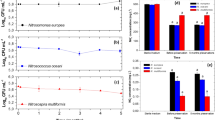Abstract
Aniline aerofloat (dianilinodithiophosphoric acid (C6H5NH)2PSSH) is a widely used phosphorodithioic organic flotation collector that contains aniline groups and dithiophosphate groups. In the present study, sodium hypochlorite solution was used to oxidize aniline aerofloat. The effect of operational parameters and optimum oxidation conditions on aniline aerofloat was studied, and the oxidation pathway of aniline aerofloat was proposed by analyzing its main oxidation intermediates. The results showed that NaOCl concentration had a significant influence on aniline aerofloat oxidation and at 100 mg/L aniline aerofloat, 84.54 % was removed under the following optimal conditions: NaOCl concentration = 1.25 g/L, pH = 4, and reaction time = 60 min. The main reaction of aniline aerofloat by NaOCl included N-P bond cleavage, aniline group oxidation, aniline group chlorination, and dithiophosphate group oxidation. The initial reaction was the N-P bond cleavage and the anilines and dithiophosphate was further oxidized to other intermediates by five parallel reaction pathways.







Similar content being viewed by others
References
Chen WS, Huang CP (2015) Mineralization of aniline in aqueous solution by electro-activated persulfate oxidation enhanced with ultrasound. Chem Eng J 266:279–288
Chen YC, Lu C (2014) Kinetics, thermodynamics and regeneration of molybdenum absorption in aqueous solutions with NaOCl-oxidized multiwalled carbon nanotubes. J Ind Eng Chem 2014:2521–2527
Cheng H, Lin H, Huo H, Dong Y, Xue Q, Cao L (2012) Continuous removal of ore floatation reagents by an anaerobic-aerobic biological filter. Bioresour Technol 114:255–261
Gong GZ, Wei XY, Zong ZM (2012) Separation and analysis of the degradation products of two coals in aqueous NaOCl solution. J Fuel Chem Technol 40:1–7
Gu ZP, Sun SY, Xiao HH (2006) Experimental study on treatment of beneficiation wastewater by Fenton reagent. Water Resour Protect 22:82–84
Hussain I, Zhang Y, Huang S, Du X (2012) Degradation of p-chloroaniline by persulfate activated with zero-valent iron. Chem Eng J 203:269–276
Junwei D, Fengqiu C, Sufang W, Shunxi R (2000) Pathways of aniline oxidation in supercritical waster. J Chem Indust Eng(China) 51
Kádár M, Nagy Z, Karancsi T, Farsang G (2001) The electrochemical oxidation of 4-chloroaniline, 2,4-dichloroaniline and 2,4,6-trichloroaniline in acetonitrile solution. Electrochim Acta 46:1297–1306
Li Y, Wang F, Zhou G, Ni Y (2003) Aniline degradation by electrocatalytic oxidation. Chemosphere 53:1229–1234
Lotter NO, Bradshaw DJ (2010) The formulation and use of mixed collectors in sulphide flotation. Miner Eng 23:945–951
Madsen HT, Søgaard EG, Muff J (2015) Study of degradation intermediates formed during electrochemical oxidation of pesticide residue 2,6-dichlorobenzamide (BAM) in chloride medium at boron doped diamond (BDD) and platinum anodes. Chemosphere 120:756–763
Sarasa J, Cortés S, Ormad P, Gracia R, Ovelleiro JL (2002) Study of the aromatic by-products formed from ozonation of anilines in aqueous solution. Water Res 36:3035–3044
Xie X, Zhang Y, Huang W, Huang S (2012) Degradation kinetics and mechanism of aniline by heat-assisted persulfate oxidation. J Environ Sci 24:821–826
Xuefeng C, Wei M, Lei S, Yang C (2012) Electrocatalytic oxidation combined with ozone oxidation treating high concentration organic wastewater. Nonferroius Metals(Min Proc Sect) 32–35:45
Yamauti M, Hashimoto M, Sano H, Ohno H, Carvalho RM, Kaga M, Tagami J, Oguchi H, Kubota M (2003) Degradation of resin-dentin bonds using NaOCl storage. Dent Mater 19:399–405
Yao JJ, Gao NY, Li C, Li L, Xu B (2010) Mechanism and kinetics of parathion degradation under ultrasonic irradiation. J Hazard Mater 175:138–145
Youquan L, Rongshang L (1994) Study on properties of aniline aerofloat. Min Metall 3:50–54
Yunjie L, Jialin L, Shuiyu S (2015) Ozone oxidation degradation of aniline aerofloat simulated wastewater. Chin J Environ Eng 9:1161–1164
Acknowledgments
This work was supported by Education Special Funds of the University Discipline Construction of Guangdong Province (Grant No. 2014KTSP022), Nature Science Foundation of Guangdong (2015A030303003) and Science and Technology project of Guangdong (2014B020216009).
Author information
Authors and Affiliations
Corresponding author
Additional information
Responsible editor: Santiago V. Luis
The highlights of the study are as follows:
1. The effect of operational parameters on aniline aerofloat oxidation is evaluated.
2. The optimum oxidation conditions are obtained.
3. The intermediates of aniline aerofloat are identified and the possible oxidation pathways of aniline aerofloat are firstly proposed.
Rights and permissions
About this article
Cite this article
Lin, W., Tian, J., Ren, J. et al. Oxidation of aniline aerofloat in flotation wastewater by sodium hypochlorite solution. Environ Sci Pollut Res 23, 785–792 (2016). https://doi.org/10.1007/s11356-015-5319-4
Received:
Accepted:
Published:
Issue Date:
DOI: https://doi.org/10.1007/s11356-015-5319-4




